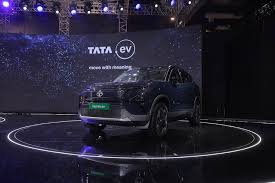Tata Motors, one of India’s leading automobile manufacturers, is set to launch its highly anticipated Harrier EV on June 3, 2025. The move marks a significant step in the company’s electric vehicle (EV) roadmap, bringing a well-known internal combustion engine (ICE) nameplate into the rapidly evolving premium electric SUV space.
The Harrier EV, first previewed at the Bharat Mobility Global Expo earlier this year, will be positioned as a direct rival to Mahindra’s upcoming BE.6 SUV. With this launch, Tata is aiming to fortify its dominance in the EV segment, while signaling its readiness to compete in higher-end categories.
A Platform for the Future
The Harrier EV is based on Tata’s new ‘acti.ev+’ architecture—an advanced iteration of its OMEGA platform that underpins the ICE Harrier. Designed with an EV-first mindset, the platform offers a flat floor to maximize interior space, while supporting flexible battery and motor configurations. The vehicle will reportedly offer dual-motor all-wheel drive, with a peak torque output expected to reach 500 Nm.
Design-wise, the Harrier EV retains much of its ICE sibling’s aesthetic appeal, but introduces several EV-specific cues: a sealed front grille for better aerodynamics, new LED lighting signatures, aero-optimized alloy wheels, and a redesigned rear with EV badging.
Performance and Premium Ambitions
Though official performance specifications have yet to be confirmed, Tata Motors has hinted at a real-world driving range exceeding 500 kilometers on a single charge—placing it in direct competition with upcoming models from Mahindra, BYD, and Hyundai.
This launch represents a strategic push by Tata to bridge the affordability of its Nexon EV range with a more premium, feature-rich offering for urban and long-distance drivers. Analysts see it as a critical test for Indian automakers competing with global entrants.
Inside, the Harrier EV is expected to feature the same upscale amenities found in its ICE counterpart, including a 12.3-inch touchscreen infotainment system, 10.25-inch digital cluster, ventilated front seats, dual-zone climate control, wireless phone charging, and a 10-speaker JBL audio system. Over-the-air (OTA) updates and vehicle-to-load (V2L) functionality are also likely.
Electric Competition Heats Up
The launch comes at a time when India’s EV market is undergoing rapid transformation. With consumer demand growing and infrastructure slowly expanding, competition in the electric SUV segment is intensifying. Tata, which already leads in market share thanks to its Nexon EV, is now aiming to extend that lead by offering more powerful, tech-forward options.
Industry observers believe the Harrier EV could set a new benchmark for locally produced electric SUVs, offering a blend of performance, range, and comfort at a projected starting price of ₹24 lakh, with top-end variants expected to touch ₹30 lakh (ex-showroom).
Bookings are expected to open immediately after the launch, with deliveries anticipated later this year.


